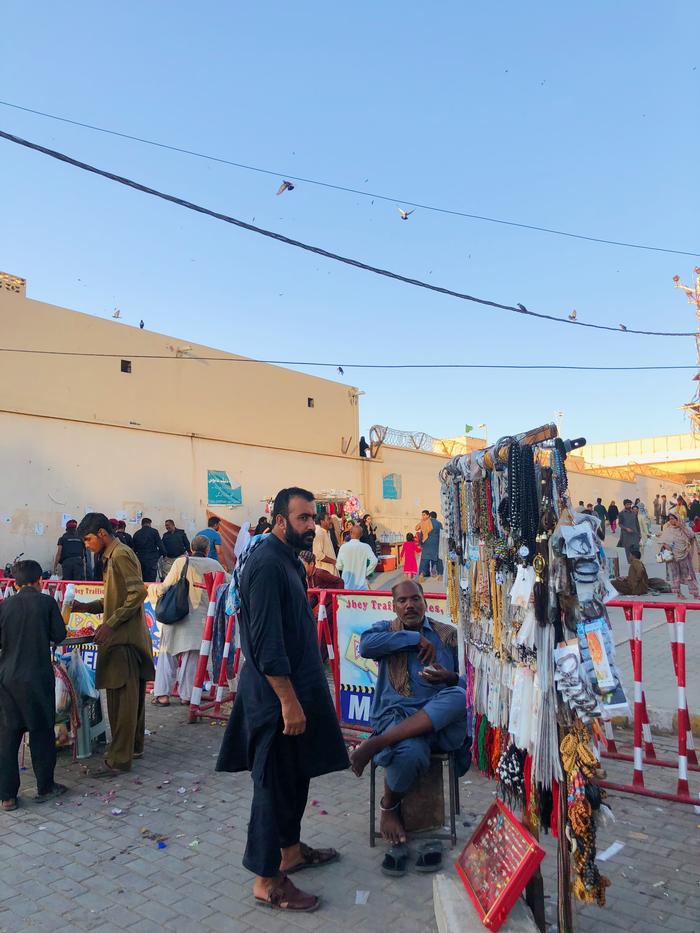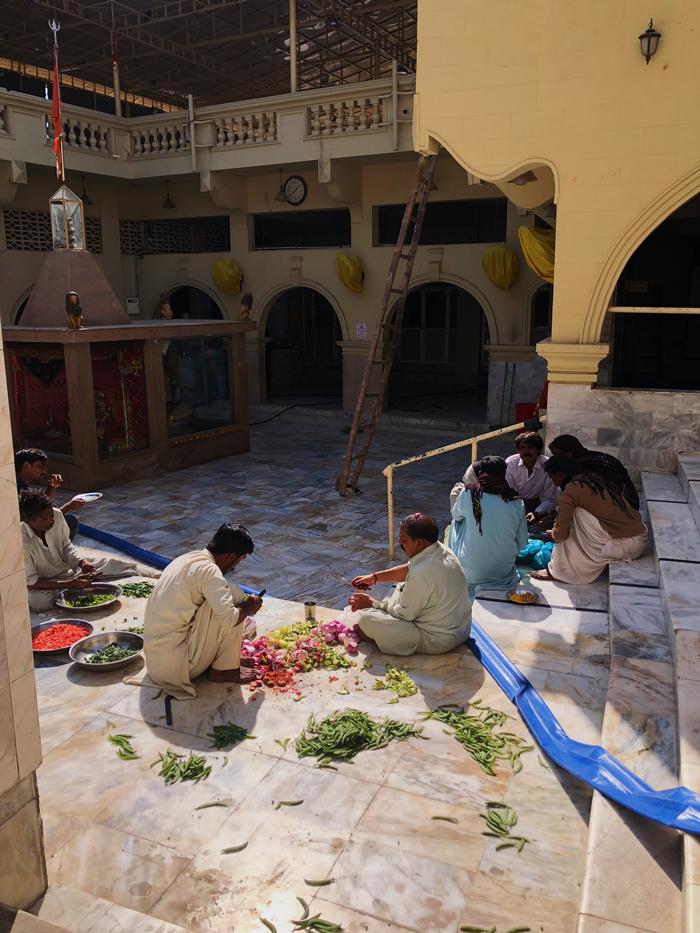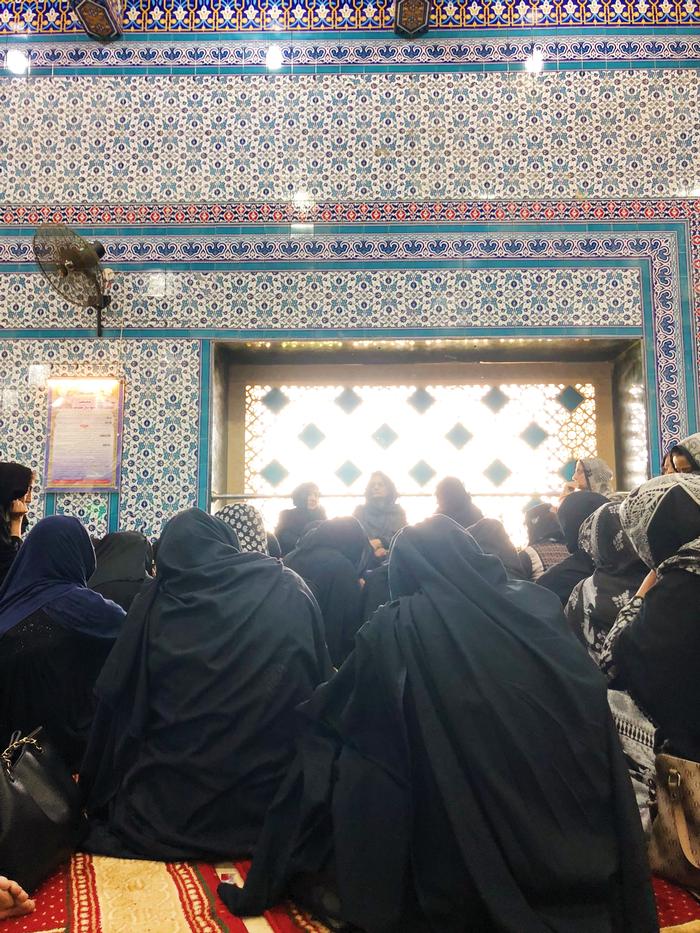[ID:3815] Sacred meets Profane: Demystifying Religious Influence over Community SpacesPakistan Through teaming up, our similarities, as well as our differences, help us in this endeavor. Majoring in different disciplines (Architecture and Social Development) allows us to approach civic buildings and their central role in public life through a diverse, interdisciplinary perspective thus enabling us to better understand the sociocultural dynamic at play.
To understand the background of the civic spaces we have chosen, it is imperative to understand the context they exist in and cater to. The conception of both the spaces predates the existence of the city that houses them. The local interest of what would come to be known as the city of Karachi was, initially, also generated through the popularity of these spaces. Together, along with a few other religious spaces, they form a sacred geography, unique only to the coastline of Karachi. The historically significant coastline is often described as a cultural belt which is an all inclusive space that welcomes and accommodates people from all sects, casts and religions. This distinctive clustering of civic spaces along the Arabian Sea is what sets apart our chosen spaces from the rest.
The Mazar (Shrine) of Abdullah Shah Ghazi is the first sacred space on the belt that creates an intercultural space for the residents of the city and beyond. It is considered to be one of the oldest, most recognizable landmarks of Karachi and has a history which predates the Partition. Abdullah Shah Ghazi was a revered Sufi saint whose tales are still famous amongst the residents of the subcontinent. The hrine was built in the 9th century and caters to a wide religious audience comprised mostly of Muslims but not limited to them as it welcomes Hindu and Christian devotees that look up to the saint for guidance. It sits atop a hill that elevates its significance and anchors its spiritual presence in the city. Regarded as a sanctuary that marks the Sufi saint’s final resting spot, the shrine acts as a beacon of hope and guidance for the pilgrims that use and occupy its premises as a civic space.
The morphological evolution of the building along the passage of time has largely been ignored by modern historians. However, this building has played a central role in forming the city’s identity which can’t be overlooked. It is regarded as the nucleus that prompted the growth of other activities to spurt around it. The main transformations took place in the 19th century when the British started to develop the coastline by creating recreational buildings and promenades. The most important thing to note during this development period was that the shrine was left untouched due to its highly religious connotations. This sensitivity to the shrine is one thing that the recent neo-liberal urban development of the area has failed to incorporate which has greatly affected the social practices of the space itself.
The Shri Ratneshwar Mahadev Mandir (Temple) is the second sacred space along the coastline that has a notable impact on the city’s residents and their usage of the communal space. The temple like its Muslim counterpart enjoys a deep rooted history that gives the space it occupies, an elevated sense of importance and belonging. The Mandir humbly resides within the depth of the streets, only to be found if one looks for it. In contrast, the Shrine announces its presence boldly, occupying one of the main roads. The Mandir shares a small section of land as compared to the wide expanses of terraced fields of Bagh Ibne Qasim, an urban park where it is situated in. The temple’s patron deity is Shiv Bhagwan (Lord) whose power and protection urges devotees towards the temple to dote on and pray to him. According to the legend, Lord Shiv and Parvati (his wife) traveled through this very cave, which is what attracts thousands of Hindus to visit the Mandir.
The temple which is deep recessed underground, in a cave inside a hill, houses a 500-year-old Shivling that helps to date the creation of the temple itself. It is said that in the past the cave remained submerged under the sea for most of the year however, as time progressed and the shoreline recessed, what is seen now as the present day temple emerged. The legends and myths attached to the Mandir contribute to its success as a multicultural public space that caters to a diverse range of inhabitants making it vibrant. However due to the recent urban regeneration agendas in the area the Mandir and its organic structure have consequently faced significant threats that could hinder the public activity that manifests within its walls.
Structurally and religiously the Mandir and the Shrine are on complete opposite spectrums as they cater to contrasting objectives. However, if one compares the essence of their existence, the similarities outweigh the differences due to the fervor and zeal of the community which enriches these spaces. Both spaces regardless of their structures allow inhabitants of the city to come together and experience the sense of oneness. The commonality in catering to and carrying out religious responsibilities is another feature that unites the participants of both the spaces and contributes to the overall Genius Loci which is the same for both the spaces.
The major difference is felt upon entering the space, where a sense of urgency is experienced, as throngs of people make their way upwards into the enclosed surroundings of the Mazar. The threshold of the road to the paved walkway meandering towards the gates is what sets things into motion as this is where most pedestrians are embarking on or departing from the Shrine. Even though the Shrine has its own parking space it largely goes unused as it is separated from the main circulation route by an adjoining access route.
The main entrance to the site is on the corner of an intersection of a very busy road which doesn’t allow for much leeway in traffic flow. This entrance is where the most mixed activity is experienced as vehicular and pedestrian traffic collides and fights for an open route. This tug of war hinders the circulation of the communal space the most as another communal activity that takes place here fights for equal attention. This activity is that of hawkers that occupy most of the walkway and have thus situated themselves such for maximum user interaction.
The pausing of individuals to peruse through the multiple wares such as food and trinkets being sold is what causes disruption in the general flow of traffic where walking lanes are blocked by bystanders. On the other hand, this is the only refuge for these poor sellers as they are otherwise hounded for extortion and relocated by state-sponsored anti-encroachment wings. This spontaneous clustering of activity on major days such as Thursdays also leads to the creation of a hustling and thriving bazaar that caters to hordes of people coming to the Mazar. This is the only form of entertainment for most of the economically drained inhabitants of the city who can’t afford other more legit retailers.
The Mandir in contrast experiences a complete opposite interaction with the user traffic that navigates through its premises. The access of the temple is set back from the main road which allows the traffic to smoothly filter in and occupy the empty spaces in the massive car park that is situated before the entrance. The vehicular traffic is allowed to fully come to a rest before pedestrians take off from their vehicles and make their way towards the entrance on foot. The separation of traffic using different thresholds to mark accessibility is what makes the Mandir most effective to reach to, without interruption. Hawkers are present on the premises here too, however their positioning, around the walkway that leads to the main door, is structured and less chaotic than the Mazar’s.
This uninterrupted peaceful passage is mostly due to the location of the Mandir which enjoys a set back due to the urban park it resides within the premises of. The scale of the Mandir is also smaller to the Mazar which also affects the population it receives. The Mazar enjoys a central location and is accessible to all whereas the Mandir is offsetted and is exclusive only to the Hindu population of the city which drastically decreases the attention it receives in terms of the user. Another major difference is in the positioning of thresholds inside the two spaces which determines the intensity of the traffic flow.
The actual journey of devotion begins after the taking off of shoes and crossing the entrance portal which marks the physical threshold of transition from the material world into the sacred. After surpassing the entrance, a similarity is immediately noticed in structures where both the spaces employ the use of stairs to either ascend towards the sky (Mazar) or descend deeper in to the ground (Mandir). Both the spaces rely on stairs to create a pilgrimage towards the final destination of the religious enclosure which marks the culmination of the sacred journey.
This allows a process of retrospection and introspection to take place within the pilgrim’s mind that focuses their attention solely to the act of devotion they’re about to perform rather than their surroundings. This process is important as it creates a sense of oneness with the civic space and prepares the devotee with a participatory demeanor for them to engage more freely in religious communal activities.
Another striking similarity is in the orientation and allocation of open spaces inside the structure that provide for spontaneous programs to emerge and take place in. This space it seems is where the profane deeply manifests itself within. The emergence of activities performed by the general public in order to engender a community spirit which slowly becomes the manifesto of the civic structure is what the profane comes to be known as. The profane hangs in the middle of all the sacred connotations the religious space gives way to. This is marked by the existence of courtyards within the enclosure of the civic space which act as the spaces of uncertainty and doubt which gives way to most of the social interaction within the boundaries where people spend their time observing each other and their environment, engaging in discussions and eating with each other.
Here mortal laws don’t apply as everyone treats each other as familiar, allowing themselves to be part of a greater discourse than what is directly in front of them. The court is effective in generating user activity and is acknowledged more formally as the space that links all other spaces. The most noise is generated in this area which in other parts of the enclosure is kept to a minimum out of respect of the immediate surroundings. Noise and generation of sound here, are seen as the bridge between individuals and community building activities, hence are regarded as the positive aspects of the site. The most noteworthy activation of sound is experienced in the evenings through Qawwali or Sufi Islamic devotional music, drawing huge crowds to the Shrine and likewise for the Temple through harmonious sounds of Puja. The layering of the two contradicting sounds creates an interesting composition that enhances and speaks volumes about the peaceful existence of the neighboring structures.
The community spirit is particularly evident in two prominent activities that take place specifically in these spaces. The first being the creation and distribution of Langar. Langer is the distribution of free food and drinks for anyone who wishes to partake of it. Food preparation and creation which is typically looked at as a women’s job is taken up by men who prepare food from scratch for everyone. People in droves are seen to participate in this process as it’s regarded as a great act of charity and community building that everyone wants to be associated with. People of all ages are seen participating in this activity where the old adopt an active role in observing and conversing with people around as children run amok waiting for food to arrive.
The second activity is a religious tradition that is typically observed by men, that being of storytelling. In the women’s section, an enthusiastic engagement in Dars, Majalis and other forms of religious storytelling traditions is witnessed. Women in communal spaces are not granted a lot of autonomy in the country due to a host of sociocultural barriers, however the religious sphere is something they exert a special status over and actively form a community around. Here through the process of storytelling, generations of young and old women come together to lament and discuss old tales and their significance in their personal lives. This allows for a unique education to take place which might not be regarded as formal but instills an in-depth knowledge within the listeners. The temple and shrine thus are not constrained to functioning as sacred spaces; they are in addition vibrant and dynamic community spaces.
The recent neo-liberal urban regeneration of the area however has affected both the spaces and the community they cater to. The redesign of the surroundings to suit modern requirements has created a rift in the pedestrian connectivity of the scared geography the area was known for. Due to the creation of a high rise that features a mall on the ground floor level right next door to the Mazar it has created a disruption in the overall Genius Loci of the space.
Where once lied the tallest structure in the area that being the Mazar now lies an urban monstrosity that infringes on the property of the Mazar. The same insensitive approach has disrupted the organic nature of the Mandir a few kilometers down the road as well. Due to underpasses being created to accommodate the flow of traffic to the mall the digging has disrupted the foundations of the underground mandir as well. These insensitive disruptions are made under the banner of modernization which seems to be synonymous with positive progress.
This modern requirement of communal spaces is highly insensitive to the existing typologies of civic architecture that predates the current structures by centuries. Structures such as the Mazar and the Mandir are considered as an outdated requirement despite having thriving modern engagements and relevance to the context they are created for. Our perception of social environments and civic spaces is being alienated from the context they should serve, towards more artificial solutions to cater to a problem that manifests itself differently in our part of the world. The need is to sensitively look for the solutions that enhance the communal activity we currently have and preserve them rather than demolishing them and starting anew.
Resources: 1. Nadeem F. Paracha, Abdullah Shah Ghazi The Savior Saint (http://www.dawn.com/news/1145799) 2. James Mill, The History of British India (London: Baldwin, Cradock and Joy, 1817) 3. Shashi Tharoor, An Era of Darkness: The British Empire in India (Aleph, 2016) 4. Gazetteer of the Province of Sind. B Volume 1 Karachi District 1919. 5. Arif Hasan, The gentrification of Karachi’s Coastline.
If you would like to contact this author, please send a request to info@berkeleyprize.org. |




